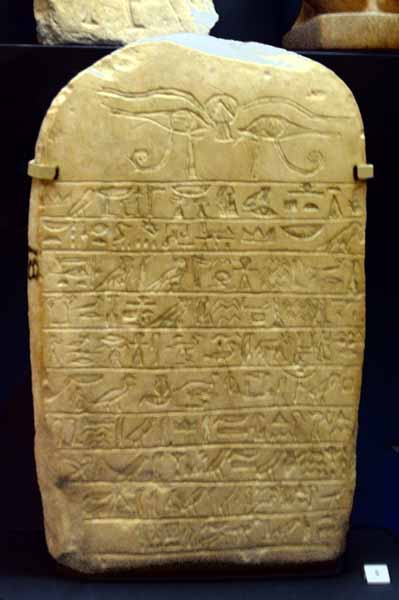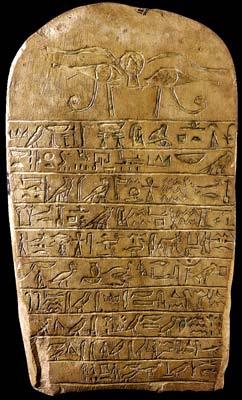
 The
text reads: '(1) A gift that the king gives (to) Osiris. Lord of Busiris,
the Great God, Lord of Abydos. (2) and (to) Horus. Lord of Foreign
Land[s], that they may give an invocation offering consisting of bread
and beer, oxen and fowl, and all things (3) good and pure, on which a
god lives, which heaven creates and (4) earth makes, which Hapy (the
Nile Indundation) brings as his perfect offering, for the spirit (5) of
the nobleman Ka. It is the son of his daughter who makes his name to
live. (6) namely the nobleman lab-user. He (Ka) says: I was a valiant
servant (7) of the ruler of Kush. I washed my feet (8) in the waters of
Kush in the following of the (9) ruler Nedjeh. I returned (10) safe and
sound (and) my family (too).'
The
text reads: '(1) A gift that the king gives (to) Osiris. Lord of Busiris,
the Great God, Lord of Abydos. (2) and (to) Horus. Lord of Foreign
Land[s], that they may give an invocation offering consisting of bread
and beer, oxen and fowl, and all things (3) good and pure, on which a
god lives, which heaven creates and (4) earth makes, which Hapy (the
Nile Indundation) brings as his perfect offering, for the spirit (5) of
the nobleman Ka. It is the son of his daughter who makes his name to
live. (6) namely the nobleman lab-user. He (Ka) says: I was a valiant
servant (7) of the ruler of Kush. I washed my feet (8) in the waters of
Kush in the following of the (9) ruler Nedjeh. I returned (10) safe and
sound (and) my family (too).'During the Middle Kingdom, the Egyptians invaded and occupied Lower Nubia (the land of Wawat), establishing a new southern border upstream of the Second Cataract. Buhen was one of a chain of great fortresses which they built along the Nile in Wawat to consolidate and extend their economic interests and to police the native population. The major aims were to control the rich goldmines of Nubia's Eastern Desert and the trade in African goods with lands further to the south. Towards the end of the 13th Dynasty (1795-1650 BC). Egypt underwent a great political upheaval and, among other consequences, was obliged to withdraw from Nubia. In the north a Canaanite dynasty, known as the Hyksos, took control of the Nile Delta and Lower Egypt. In the south Wawat and the fortresses, among them Buhen, were occupied by the forces of the powerful kingdom of Kush. based at Kerma just south of the Third Cataract. It appears that not all Egyptian personnel chose to flee. Some remained to serve the new masters.
This stela is one of a group of monuments from Buhen belonging to a single family who administered the fortress over several generations during the period of Kushite rule. A high official named Ka was the owner of the stela, which was dedicated to him by his grandson, also a high official, named Iah-user. We know from other sources that Ka was preceded in office by his father and grandfather, both named Sobekemheb. His younger brother, named Sepedhor, served as 'commandant of Buhen' and was instrumental in rebuilding the Temple of Horus at Buhen where their stelae were set up. Both proudly state that they served the ruler of Kush whose name is given on the stela of Ka as Nedjeh. There is insufficient data to decide on the precise dates of Ka and Sepedhor, and of the Kushite king in question, but the latter is perhaps to be identified as the owner of one or other of the two latest tumuli in the royal cemetery at Kerma, designated as KIV and KIII respectively, which are roughly contemporary with the mid to late 17th Dynasty (1650-1550 ac) in Egypt.